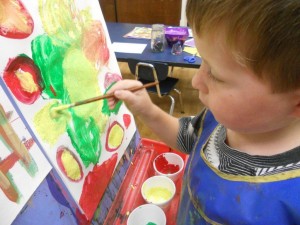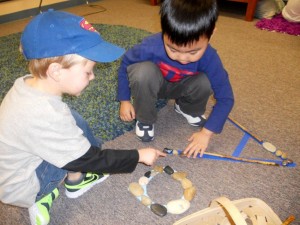The Young School and ASQ-3
A Child Care Success Story
 The Young School is a group of five year-round child care centers in the Baltimore metro area. At the King’s Contrivance location, a staff of 66 dedicated child care professionals work with infants, toddlers, and preschool-age children from 280 local families. They’ve used ASQ®-3 as their screener of choice for 4 years—with great results!
The Young School is a group of five year-round child care centers in the Baltimore metro area. At the King’s Contrivance location, a staff of 66 dedicated child care professionals work with infants, toddlers, and preschool-age children from 280 local families. They’ve used ASQ®-3 as their screener of choice for 4 years—with great results!
We talked to Jessica Trail, Head of Faculty & Administration at The Young School’s King’s Contrivance location, about ASQ-3’s positive effects on her program and the children and families they serve. Here’s what she had to say about ASQ-3’s evolving role in The Young School’s success.
Q: How did you first learn about ASQ-3 and developmental screening? What made you decide to start using ASQ-3?
A: We learned about ASQ-3 through a mentor as we began our accreditation process, and when we were awarded the Judith P. Hoyer Grant for Preschool for All. Maryland would like to emphasize developmental screening and early intervention, and that became a requirement for our grant application. We loved ASQ-3 as a parent tool because we felt that it strengthened the home to school connection and parent involvement.
Q: You’ve been using ASQ-3 for 4 years now. What effect has ASQ had on your center, staff, and/or kids and families?
A: ASQ® has helped make our staff and our families more aware of developmentally appropriate growth and development. The resources that have come with the ASQ have been instrumental for parents to provide school readiness activities at home and to understand the objectives that we cover in our plans. This also allows children to have their learning reinforced at home, and to have more individualized plans at school.
 Q: This year, you mentioned that you’ll be doing ASQ-3 for all of the kids at your center. When will parents complete the ASQ-3—at the beginning of the year or during a certain month? Do you screen more than once per year for any kids?
Q: This year, you mentioned that you’ll be doing ASQ-3 for all of the kids at your center. When will parents complete the ASQ-3—at the beginning of the year or during a certain month? Do you screen more than once per year for any kids?
A: Our PreK 2 families will be completing the ASQ-3 in October, but we will be introducing the tool to other age groups in the spring. Then the plan is to complete the screening in October for all children beginning in the 2015 school year. If a child enrolls mid-year, we will screen new children after they have been a part of our program for 90 days.
Q: Your center introduces ASQ-3 to parents during a meeting with parents. Why did you decide to introduce the screening tool this way?
A: We combine our ASQ introduction with a parent workshop to further emphasize the importance of school readiness and home to school connections. We felt that a group meeting was the best way to deliver information about the tool and to be available for questions. Our upcoming state regulation changes will require all children in our program to be screened using an approved tool within 90 days of enrollment and again each year. Because we have such a large population, we plan to hold optional informational meetings for families and incorporate the screening into our fall conferences.
Q: Can you walk us through how you introduce the tool to parents? Do you give parents any written information about ASQ-3?
A: At the meeting, we give the parents the questionnaire, as well as a letter from the school with details of how and when to complete it. We combine that with a discussion about school readiness and what Maryland expects for children entering kindergarten. We also emphasize the importance of developmental screening and having awareness of overall child development.
Q: What tips do you have for other child care centers who may be interested in holding a parent meeting before completing the ASQ-3?
A: Before holding a parent meeting, it is important to be familiar with the tool and understand the benefits that it can provide your families and programs. This can be done by utilizing one of the many resources provided, such as the User’s Guide or reviewing information on the website. Teachers can also complete the ASQ for a child so that they are familiar with how it works, which will help them answer parents’ questions.
Q: You also mentioned having teachers set up workshops to talk about the developmental domains on ASQ-3 during the parent meeting night. Can you describe those workshops?
A: We have six centers set up at the parent workshop and parents rotate through the centers, which each represent a domain. The teacher provides information about that domain of learning, as well as a list of books to support that area. Then, they do a short activity with the parents that the parents can do at home with their child, often providing the attendees with materials to take home with them. At the end of the night, the parent leaves with a full folder of information and materials that reinforces the domains within the ASQ.
Q: How have your parents responded to the ASQ-3 process? How do they respond to the introductory meeting and workshops?
A: Since we have begun using ASQ, our parents have been completely on board, and we have not had any families refuse to participate. They enjoy the connection with the school, and we have received very positive feedback about the workshop associated with it. Many parents have said that doing the ASQ helps them to know their child better and to understand more about what is developmentally appropriate.
Q: How have the teachers responded to the ASQ-3? Do you have children’s teachers complete the ASQ-3 questionnaires as well as the parents?
A: Currently, our teachers receiving funding from the grant are the ones responsible for the parent workshop, overseeing the ASQ scoring, and meeting with the parents if there are any concerns. Their feedback is that it is an informative tool that is very easy to use and very simple to lend support to parents. When there is an area of concern, we complete the ASQ at school as well or if we see a discrepancy between home and school.
Q: What is your process if a child’s ASQ-3 has scores in the monitoring zone (gray area) or below the cut-off score (black area)?
A: If a child scores in the gray or black area, we have a meeting with the parent where the teacher and director review the scores and discuss areas for concern. Often, in the gray area, we continue to monitor the child in that particular area and individualize our lesson plans to booster skill sets in that domain. We then reevaluate the child’s progress in 90 days. If a child falls in the black area, we walk the family through the process of early intervention in our county and support them through the recommendation process.
Q: In general, how have parents responded to receiving their child’s ASQ-3 results when they are in the monitoring zone or below the cut-off?
A: Parents have always responded positively. Because of the amount of communication from the school and our developmentally appropriate summary reports, parents are not often surprised when their child is monitored or needs to be referred for outside services. Most often they follow our recommendation of next steps and are grateful for the tool to understand developmentally appropriate behavior and skills.
Q: You mentioned that you use the activities in the back of the ASQ-3 User’s Guide with parents. Can you describe how you use them? How have parents responded?
A: When the ASQ-3 screening tools are distributed to our families, we copy the age-appropriate activities from the User’s Guide as a reference for the parents. They love being able to have even more ideas to utilize at home to reinforce learning. We use these in conjunction with activities the teachers have developed on their own incorporating the project approach. Parents have said that the activities from ASQ-3 are very easy to implement at home.
ASQ-3 has been a great success at The Young Center—and now, with Maryland’s new requirement that all children receive developmental screening, the Center plans to expand ASQ-3 use so it can help even more children. Starting in 2015, ASQ-3 will be used with all children at all the Young School locations in Maryland. (The other locations already have ASQ-3, but right now, they only use it when they have a concern about a child.)
With ASQ-3 in place as their official screener, The Young School centers will be ready to catch developmental delays and connect kids with intervention when it does the most good—during a child’s crucial early years. They’ll also have an easy way to encourage parents’ involvement in their child’s development and maintain open, consistent communication with families. In the years to come, ASQ-3 will be instrumental in helping all The Young School centers keep the development of Maryland’s children on track!



